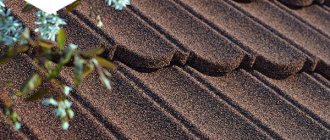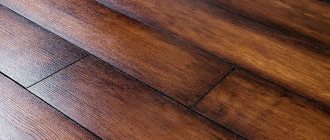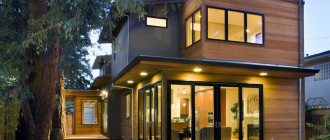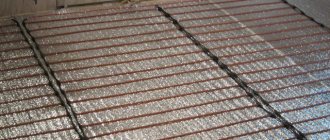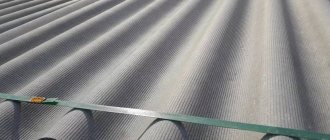The reliability of any building, as well as the comfort of living in it, depend mainly on how well its roof is constructed.
And one of the criteria for the quality of a roof is its slope.
Since the amount of roofing material also depends on its size, the choice of the angle of inclination and its preliminary calculations are made before the purchase of the selected roofing material.
Calculation of permanent and dynamic loads
When determining the slope of a pitched roof, first calculate the loads that may fall on it. They can be permanent or dynamic. Constants include the mass of the roofing covering, chimneys, antennas, dishes, and so on - since they are always an integral part of the roof.
Dynamic or variable loads include those that occur with some frequency. These include: snow, hail, the presence of a person with all repair tools and materials. To this we can also add the wind, which can tear off pitched roofs due to the windage of the roofing covering.
Loads caused by snow precipitation
If we imagine that the angle of a pitched roof will be equal to 30º, in winter, a force of 50 kg will be applied to each square meter of roofing. It’s the same as having one person sitting on every square meter.
If you make a slope of more than 45º, then, most likely, the snow simply will not be able to stay on such a roof (much, of course, depends on the roughness of the roofing material). But for regions of Russia located in the middle zone with snowfalls of average intensity, a pitched roof slope of 30-35 degrees is sufficient.
The permissible minimum slope of the canopy for independent snow removal is 10º. The maximum slope is 60º - it is impractical to build a roof with a steeper angle.
Owners of pitched roofs with insufficient slope often take up a shovel. Only the coverage area can be saved, since as it decreases, the chance of sagging of the roofing material also decreases.
Wind loads
Everything is different in windy areas - with large angles it is strictly prohibited to build pitched roofs from corrugated sheets. For example, a shed roof with a 45-degree slope must resist wind forces that are 5 times greater than those that act on an 11-degree slope. Based on this, keep in mind that a pitched roof must be constructed in such a way that its low part is located towards the leeward side.
Mixed loads
Do not forget to additionally calculate for a pitched roof such indicators as the combination of short-term factors with negative ongoing loads. This refers to critical values that can affect the rafter system. Many, oddly enough, quite often do not take this factor into account, guided by the fact that if the roof can withstand snow, then it will withstand any exposure to wind.
Imagine that several people will have to climb onto the roof in heavy snow under gusts of wind. Will it be able to withstand several people, snowfall and strong winds at the same time? At such moments, all sorts of unpleasant incidents happen.
Preparatory work for roof installation
Before you begin work on installing a slate roof, prepare all the necessary tools and a flat area on which you will cut the sheets and drill holes in them. The area should be such that the sheet can be approached from any side.
Tools and equipment
To install a slate roof you will need: a hammer, slate nails or self-tapping screws, a drill, a grinder or a hacksaw, a respirator, paint for painting the cuts, a stepladder, a ladder, ropes, metal hooks.
How to lift slate onto a roof
Those who plan to do their own roofing often have the question of how to lift slate onto the roof. This is done using a rope and two hooks. The sheet is hooked from below with two hooks to which a rope is tied. The rope along with the slate sheet is pulled onto the roof. You can feed the sheets by hand using a stepladder if the work is performed by two or three people.
Preparing slate sheets
Before laying slate on the roof, if necessary, unpainted sheets can be impregnated with a water-repellent composition or painted with acrylic, water-dispersion or alkyd paint. The paint closes microcracks, makes the slate smoother, and snow rolls off it more easily in winter.
Depending on the ambient temperature, slate is subject to deformation, so there should be a small gap between the nail and the asbestos cement. It is made by drilling holes in the ridge of slate 2-3 mm larger in diameter than the nail. You can drill these holes at the place where the sheets are laid, if it is more convenient.
Determining the minimum slope of a pitched roof
When deciding what slope a pitched roof should have, it is worth noting that there are quite wide boundaries: from 6 to 60 degrees. Everything is determined by the region in which it is planned to build the house. If you do not want to suffer from tons of snow falling on your roof year after year, then build a roof with a steeper slope. And if you plan to protect yourself from the wind, then build a roof with a flatter slope. Much, of course, will depend on the aesthetic preferences of the owner.
Pitched roofs with a high slope
The higher the angle of such a roof, the less time it takes to drain water into the gutters. Neither leaves nor various debris will accumulate on it, which means the roofing material can last much longer. In addition, such a roof will look much more aesthetically pleasing in appearance, which will mean a lot to many owners.
Shed roofs with a slight slope
Naturally, from roofs with a slight slope, rain and melt water drains more slowly; as a result, it can begin to stagnate, ice will begin to get stuck in the drains, and dirt will also accumulate. Such roofs quickly become covered with moss and leaves stick to them. The worst thing is if the roofing material has a rough coating.
When deciding what angle a pitched roof should have, you need to provide such a structure so that precipitation and melt water do not linger on it, but roll off with ease. With a low slope, water will begin to collect in all the flaws in the roof. And over time, it will be able to penetrate inside the roof, causing many problems, such as dampness, damage to the insulation, and rusting of the metal components of the roof frame.
But in this case there is also a positive side: with a smaller slope, the geometry of the interior rooms becomes closer to the “familiar” cube. For many, it is easier to perceive, and at the same time it can be used with greater impact. This means that with a lower pitch, the roof will require more waterproofing to prevent water from entering the rafter system. Here you will need to purchase protective coatings, such as membranes, insulation in rolls or sheets.
With a minimum roof angle with one slope
Quite often, pitched roofs with a slope of only 3-5% are constructed as inversion roofs. This means that such a roof will be able to withstand additional increased loads: it is safe to walk on it, you can grow a garden on it, or even use it as an open terrace. It is worth noting that there is a certain angle at which a pitched roof can redirect the air flow, removing accumulated precipitation in the desired direction.
The influence of the angle of inclination on the volume of the attic room
If a house is being built with an attic, then the angle of inclination of the slopes acquires practical significance. And here the relationship is direct, that is, the larger the angle, the larger the volume of the attic. To make it clear, this is clearly visible in the photo below.
The ratio of the angle of inclination of the slopes to the volume of the attic room Source legkovmeste.ru
Here's an example based on the top picture. Here you can clearly see that the height of the room depends on the roof slope parameters. It should be taken into account that the optimal height should not be less than 2.5 m. This means that the angle of inclination of the attic slopes should be at least 25°. But please note that with this arrangement of roofing elements, the volume of the room is not taken into account. That is, the width of the room will not be more than 3 m. This despite the fact that the width of the house is 10 m. It turns out that only 30% of the space is used.
This means we need to increase the angle value. And the larger it is, the larger the usable area of the attic. But there is another side to the coin. By increasing the angle, the height of the ridge increases. And this is the cost of building materials for the construction of the roof, plus an increase in the windage of the structure. Therefore, it is very important to find a middle ground. For example, 40° practically solves all problems.
To get away from these problems once and for all, builders have long been using a completely different design. It is complex both in construction and in calculations, but this option solves the problem of usable area of the room without increasing the height of the roof.
Mansard roof design Source ok.ru
What angle of inclination should be in this or that case?
Based on their functionality, pitched roofs are divided into three main types: ventilated, unventilated and mixed. Each of them is worth considering in more detail.
Ventilated design
Closed structures are equipped with such roofs. The role of ventilation is played by vents and specially designated gaps between the layers of insulation, through which the air carries droplets of moisture outside the insulation.
Without such ventilation, moisture will begin to accumulate inside the insulating material, causing it to become damp and deteriorate. After some time, the entire roofing pie will become unusable. A ventilated pitched roof has a number of limitations. The angle of inclination of such a roof can only be in the range from 5 to 20%, otherwise air flows will not be able to circulate well enough through the vents.
Non-ventilated design
To understand what slope a shed roof should have, you need to consider a roof without ventilation. As a rule, such buildings are erected on highways and utility structures. Often, such roofs have an angle ranging from 3 to 6%, however, there are no strict restrictions on the slope.
Such roofs, by and large, do not need ventilation, since the air masses in rooms where there are no walls or doors are wide open circulate quite well, carrying any water vapor out into the street. Although, in such buildings, moisture practically does not collect on its own.
Mixed design
Such roofs combine the characteristics of the two previous types of construction. In this case, the slope of the roof is given by thermal insulation. It turns out to be quite economical, but in winter you will need to clean the roof of snow quite often.
The design of such a pitched roof is somewhat different: in addition to corrugated sheeting, insulation is additionally laid in two layers and high-quality waterproofing is made.
In addition, the angle is determined by the type of connection of the rafters to the mauerlat or walls.
We calculate its value
For a single slope
Since a pitched roof rests on walls of different heights, the formation of a given angle of inclination is carried out by simply raising one of the walls.
We draw a perpendicular L d along the wall, originating at the point where the short wall ends and resting on the wall that has the maximum length.
The result is a right triangle.
In order to calculate the length of the side L bc, you need to use the trigonometric formula.
If the length of the wall L сд is equal to 10 meters, then to obtain a slope angle of 45 degrees, the length of the wall L bc should be equal to 14.08 meters.
For gable
The calculation principle for a gable roof is similar to the previous principle.
Let's look at an example
Leg C is half the width of the building.
Leg a is the height from the ceiling to the ridge.
The hypotenuse is the length of the slope.
If we know any two parameters, then the angle of inclination can be easily calculated using a calculator.
If the width is 8 and the height is 10 meters, then you should use the formula:
cos A = c+b
Width c = 8/2 = 4 meters.
As a result, the formula looks like this:
cos A = 4/10 = 0.4
Using the Bradis tables, we find the value of the angle to which a given cosine value corresponds.
It is equal to 66 degrees.
Deciding on roofing covering
Before calculating the angle of a pitched roof, it is worth keeping in mind that modern roofing coverings also have their own requirements for the permissible limits of the slope of a pitched roof.
Different roofing materials have their own acceptable limits:
- corrugated sheeting – 8º-20º;
- rebated covering - 18º-30º;
- slate - 20º-50º;
- soft type of roofing - 5º-20º;
- metal tiles - 30º-35º.
For smaller slopes you will need budget materials: roofing felt, corrugated sheets and similar ones.
Surprisingly, even for roofs with a low slope, today they produce the same roofing materials as for roofs with a slope of 30 degrees.
Design options
A pitched roof is one half of the most common design option - a gable roof. From a design point of view, this is much simpler, since you only need to increase the height of one wall and reduce the size of the opposite one.
The construction of the rafter system is simplified, since the entire roof is a single plane without ribs or hollows Source yandex.ru
There are two design options:
- Ventilated . They are distinguished by the presence of a ventilation gap between the roofing and the rafter system.
- Non-ventilated . They are laid tightly on the supporting structure, without an air gap.
The fundamental difference between them is the area of use - ventilated roofs are needed only on residential buildings.
Auxiliary premises do not require such elements Source kak-sdelat-kryshu.ru
The reason for this is that the air in living spaces contains a large amount of water vapor. It condenses on cold surfaces and soaks into materials, destroying them. Wooden and metal structural elements suffer, which sooner or later leads to the need to repair or completely redo the roof. From a design point of view, the only difference is the presence of a layer of counter-lattice between the roof and the rafter system, which creates a ventilation gap.
Which rafter system to choose
The type of fastening of the rafters to the walls is determined by the slope of the roof, as well as the loads that will fall on it.
Today there are the following types of rafters:
- Hanging . The best option if you want to get the most rigid connection, but there is no way to install an additional stop under the side supports.
In other words, only external load-bearing walls are present, and there are no partitions. We can say that such a rafter system turns out to be very complex, so its production must be carried out with sufficient responsibility. Nuances arise due to long spans and the bursting force that puts pressure on the walls.
- Layered . In this case, the entire roof exerts pressure on at least three supports: two external walls and one located inside. The rafters should be as dense as possible, with a cross-section of at least 5x5 cm for the beams, and 5x15 cm for the rafter legs.
- Sliding . This design assumes that a ridge beam will serve as one of the supports under the rafters. And to connect it to the rafters, special metal fasteners are used - “slippers”. They enable the rafter system to move forward a very short distance in case of wall shrinkage, in order to avoid the appearance of cracks. This helps the roof to easily withstand even significant shrinkage of the frame, without causing damage.
Roof slope in percentage and degrees
How to determine the angle of a roof in degrees? An inclined angle, like any similar figure according to geometric canons, is measured in degrees.
But in many documents, including SNiPs, this value is displayed as a percentage, so there are no strict requirements and justifications to be guided by only one unit of measurement.
The main thing in this situation is to know the proportions for the relationship if you suddenly need to convert degrees to percentages and vice versa, for example, for convenience during computational operations.
In general, the degree to percentage conversion factor ranges from 1.7 (for 1 degree) to 2 (for 45 degrees). In cases where indicators that are not expressed as a whole percentage are fundamentally important, ppm - hundredths of a percent - are used in digital display.
If you trust the theory, then the inclinations can reach 60 and even 70 degrees, but in practice this will not look entirely appropriate. And in appearance, the impression is “so-so”, unless your house is located somewhere in the Alps and you need to build a roof that is constantly exposed to snow loads.
Converting degrees to percentages
Calculate the height of a roof with one slope
To determine the height of the roof being built, you can use one of three well-known methods:
- geometric;
- trigonometric;
- online calculator.
The easiest way to calculate the slope of a pitched roof is to use online calculators. As a rule, they are configured to comply with SNiPs - “Load and Impact” TKP 45-5.05. However, it is worth considering that this method is best used only as an auxiliary one.
So we figured out how to determine the minimum slope of a pitched roof. We hope that you make the correct calculations and your roof will last longer than planned!
How to calculate?
To select angles of inclination, the same set of rules SP 17.13330.2017 “Roofs” is used. To calculate the load-bearing elements of the rafter system and their sections, SNiP II-25-80 “Wooden Structures” in the updated version of SP 64.13330.2017 is intended.
To calculate the slope angles of a hip roof, it is best to use some online calculator that is easy to find on the Internet. The calculations are usually based on the same mathematical algorithm.
The initial data for such calculators are:
- long width of the slope (longitudinal);
- short (transverse or end);
- ridge length;
- the height of the end triangle (the perpendicular lowered from the top vanishing point to its base - the short width of the slope);
- the height of the trapezoidal planes is the length of the line perpendicular to the ridge and the long (longitudinal) width of the slope;
- the size of the roof overhang (the amount by which the roof perimeter in horizontal projection exceeds the perimeter of the house plan).
You can also calculate the hip system manually, using constructions and formulas from school textbooks on geometry and trigonometry, using the same initial data as for automatic calculation.
For an accurate calculation, you can use the formula :
The output should be the dimensions of triangles and trapezoids, and the height of the ridge above the attic floor should be determined . You just need to make sure that the dimensions of the inclined sides (hips) of the trapezoid coincide with the dimensions of the inclined sides of the triangles (hips), and all together they converge in the ridge at the same level.
Only in this case are formed the same angles of inclination into the attic of individual planes of the hip roof from the eaves of the building relative to the verticals of the enclosing wall structures.
Calculation of the geometric configuration, dimensions, and angles of inclination of a hip roof does not automatically entail the calculation of its load-bearing capacity.
